2000 NISSAN XTERRA ignition
[x] Cancel search: ignitionPage 13 of 263

This supplemental restraint system section
contains important information concerning
the driver and passenger supplemental air
bags. The supplemental restraint system air
bags can help reduce impact force to the
driver and front passenger in certain frontal
collisions. The supplemental air bags are
designed tosupplementthe crash protec-
tion provided by the driver and front passen-
ger seat belts and arenot a substitutefor
them. Seat belts should always be correctly
worn and the driver and front passenger
seated a suitable distance away from the
steering wheel and instrument panel. See
``Seat belts'' for instructions and precautions
on seat belt usage later in this section.
The supplemental air bags operate only
when the ignition switch is in the ON or
START position.
WARNING
OThe supplemental air bags ordinarily
will not inflate in the event of a side
impact, rear impact, roll over, or
lower severity frontal collision. Al-
ways wear your seat belts to help
reduce the risk or severity of injury
in various kinds of accidents.OThe seat belts and the supplemental
air bags are most effective when you
are sitting well back and upright in
the seat. Supplemental air bags in-
flate with great force. If you are un-
restrained, leaning forward, sitting
sideways or out of position in any
way, you are at greater risk of injury
or death in a crash and may also
receive serious or fatal injuries from
the supplemental air bag if you are
up against it when it inflates. Always
sit back against the seatback and asfar away as practical from the steer-
ing wheel or instrument panel. Al-
ways use the seat belts.
O
Keep hands on the outside of the
steering wheel. Placing them inside
the steering wheel rim could increase
the risk that they are injured when the
supplemental air bag inflates.
ARS1151
SUPPLEMENTAL RESTRAINT
SYSTEM (supplemental air bag
system)
1-6Seats, restraints and supplemental air bag systems
ZX
Page 17 of 263
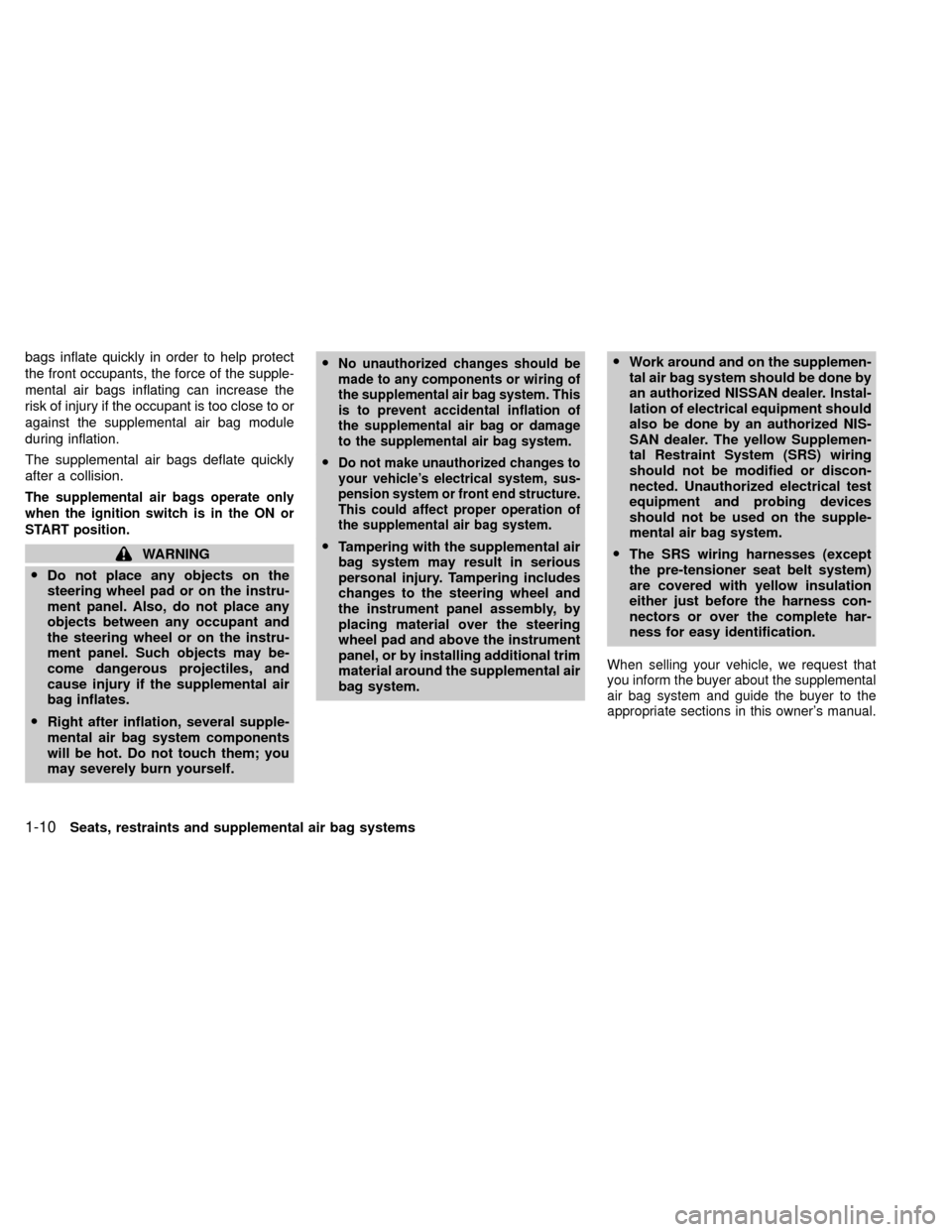
bags inflate quickly in order to help protect
the front occupants, the force of the supple-
mental air bags inflating can increase the
risk of injury if the occupant is too close to or
against the supplemental air bag module
during inflation.
The supplemental air bags deflate quickly
after a collision.
The supplemental air bags operate only
when the ignition switch is in the ON or
START position.
WARNING
ODo not place any objects on the
steering wheel pad or on the instru-
ment panel. Also, do not place any
objects between any occupant and
the steering wheel or on the instru-
ment panel. Such objects may be-
come dangerous projectiles, and
cause injury if the supplemental air
bag inflates.
ORight after inflation, several supple-
mental air bag system components
will be hot. Do not touch them; you
may severely burn yourself.O
No unauthorized changes should be
made to any components or wiring of
the supplemental air bag system. This
is to prevent accidental inflation of
the supplemental air bag or damage
to the supplemental air bag system.
ODo not make unauthorized changes to
your vehicle's electrical system, sus-
pension system or front end structure.
This could affect proper operation of
the supplemental air bag system.
OTampering with the supplemental air
bag system may result in serious
personal injury. Tampering includes
changes to the steering wheel and
the instrument panel assembly, by
placing material over the steering
wheel pad and above the instrument
panel, or by installing additional trim
material around the supplemental air
bag system.OWork around and on the supplemen-
tal air bag system should be done by
an authorized NISSAN dealer. Instal-
lation of electrical equipment should
also be done by an authorized NIS-
SAN dealer. The yellow Supplemen-
tal Restraint System (SRS) wiring
should not be modified or discon-
nected. Unauthorized electrical test
equipment and probing devices
should not be used on the supple-
mental air bag system.
OThe SRS wiring harnesses (except
the pre-tensioner seat belt system)
are covered with yellow insulation
either just before the harness con-
nectors or over the complete har-
ness for easy identification.
When selling your vehicle, we request that
you inform the buyer about the supplemental
air bag system and guide the buyer to the
appropriate sections in this owner's manual.
1-10Seats, restraints and supplemental air bag systems
ZX
Page 18 of 263

Warning labels about the supplemental air
bag system are placed in the vehicle as
shown in the illustration.The supplemental air bag warning light,
displaying
in the instrument panel,
monitors the circuits of the supplemental air
bag system. The circuits monitored by the
supplemental air bag warning light are the
diagnosis sensor unit, the supplemental air
bag modules and all related wiring.
When the ignition key is in the ON or START
position, the supplemental air bag warning
light illuminates for about 7 seconds and
then turns off. This means the system is
operational.
If any of the following system conditions
occur, the supplemental air bag system
ARS1229
ARS1230
WARNING LABELS SUPPLEMENTAL AIR BAG
WARNING LIGHT
Seats, restraints and supplemental air bag systems1-11
ZX
Page 19 of 263

needs servicing and should be taken to an
authorized NISSAN dealer:
OThe supplemental air bag warning light
remains on after approximately 7 sec-
onds.
OThe supplemental air bag warning light
flashes intermittently.
OThe supplemental air bag warning light
does not come on at all.
Under these conditions, the Supplemental
Restraint System (supplemental air bag
system) may not function properly. It must
be checked and repaired.
WARNING
If the supplemental air bag warning
light is on, it could mean that the
supplemental air bag system will not
operate in an accident.
Repair and replacement procedure
The supplemental air bag modules are de-
signed to inflate on a one-time-only basis.
As a reminder, unless it is damaged, the
supplemental air bag warning light remains
illuminated after inflation has occurred.Repair and replacement of the supplemen-
tal air bag system should be done only by
an authorized NISSAN dealer.
To ensure long-term functioning, the
supplemental air bag system must be
inspected 10 years after the date of
manufacture noted on the certification
label located on the driver side door
jamb pillar.
When maintenance work is required on the
vehicle, the supplemental air bag system
and related parts should be pointed out to
the person conducting the maintenance. The
ignition key must always be in the LOCK
position when working under the hood or
inside the vehicle.
WARNING
OOnce the supplemental air bag in-
flates, the supplemental air bag
module will not function again and
should be replaced by an authorized
NISSAN dealer. The supplemental air
bag module cannot be repaired.OThe supplemental air bag system
should be inspected by an autho-
rized NISSAN dealer if there is any
damage to the front end portion of
the vehicle, or replaced if the supple-
mental air bag has inflated.
OIf you need to dispose of the supple-
mental air bag or scrap the vehicle,
contact an authorized NISSAN
dealer. Correct supplemental air bag
disposal procedures are set forth in
the appropriate NISSAN Service
Manual. Incorrect disposal proce-
dures could cause personal injury.
1-12Seats, restraints and supplemental air bag systems
ZX
Page 21 of 263
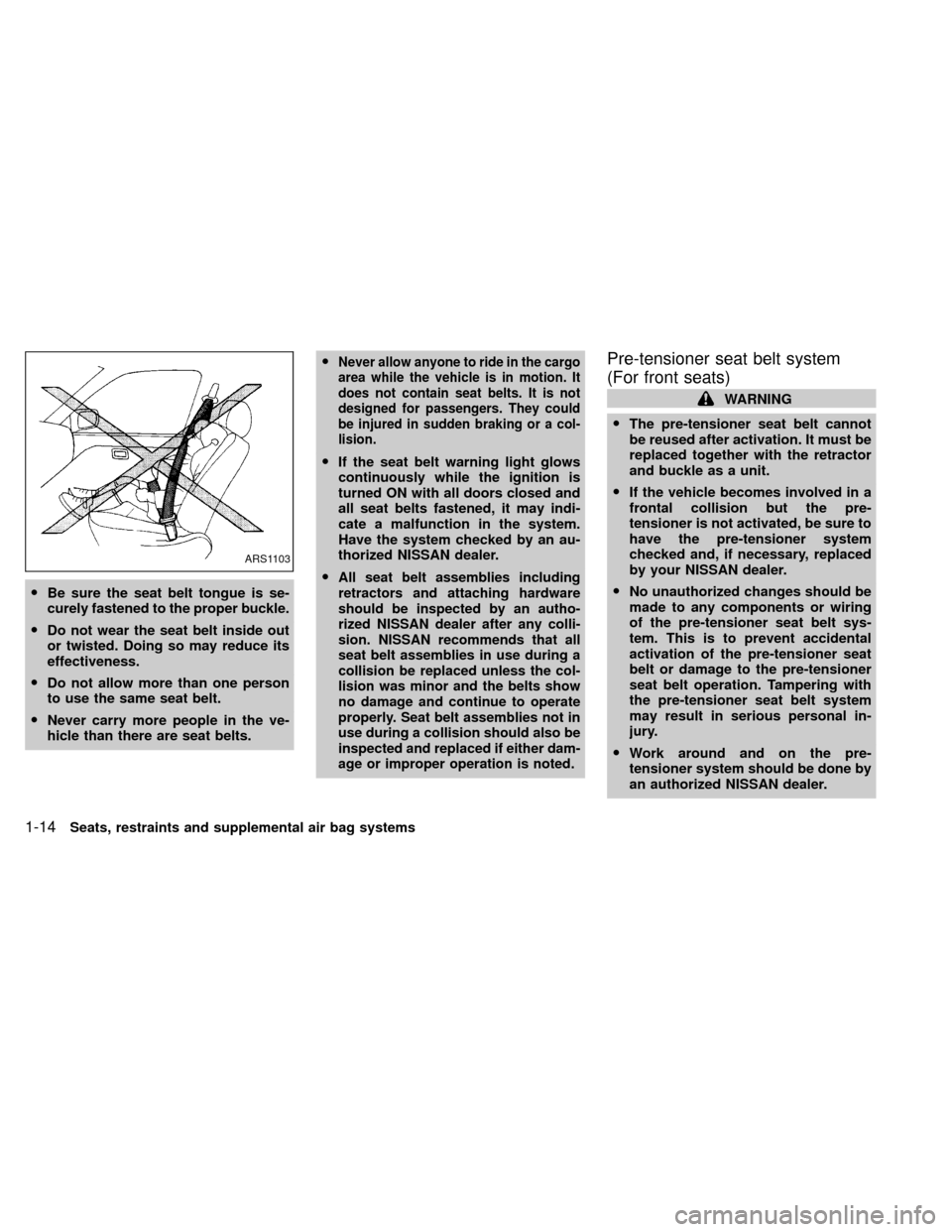
OBe sure the seat belt tongue is se-
curely fastened to the proper buckle.
ODo not wear the seat belt inside out
or twisted. Doing so may reduce its
effectiveness.
ODo not allow more than one person
to use the same seat belt.
ONever carry more people in the ve-
hicle than there are seat belts.O
Never allow anyone to ride in the cargo
area while the vehicle is in motion. It
does not contain seat belts. It is not
designed for passengers. They could
be injured in sudden braking or a col-
lision.
OIf the seat belt warning light glows
continuously while the ignition is
turned ON with all doors closed and
all seat belts fastened, it may indi-
cate a malfunction in the system.
Have the system checked by an au-
thorized NISSAN dealer.
O
All seat belt assemblies including
retractors and attaching hardware
should be inspected by an autho-
rized NISSAN dealer after any colli-
sion. NISSAN recommends that all
seat belt assemblies in use during a
collision be replaced unless the col-
lision was minor and the belts show
no damage and continue to operate
properly. Seat belt assemblies not in
use during a collision should also be
inspected and replaced if either dam-
age or improper operation is noted.
Pre-tensioner seat belt system
(For front seats)
WARNING
OThe pre-tensioner seat belt cannot
be reused after activation. It must be
replaced together with the retractor
and buckle as a unit.
OIf the vehicle becomes involved in a
frontal collision but the pre-
tensioner is not activated, be sure to
have the pre-tensioner system
checked and, if necessary, replaced
by your NISSAN dealer.
ONo unauthorized changes should be
made to any components or wiring
of the pre-tensioner seat belt sys-
tem. This is to prevent accidental
activation of the pre-tensioner seat
belt or damage to the pre-tensioner
seat belt operation. Tampering with
the pre-tensioner seat belt system
may result in serious personal in-
jury.
OWork around and on the pre-
tensioner system should be done by
an authorized NISSAN dealer.
ARS1103
1-14Seats, restraints and supplemental air bag systems
ZX
Page 22 of 263
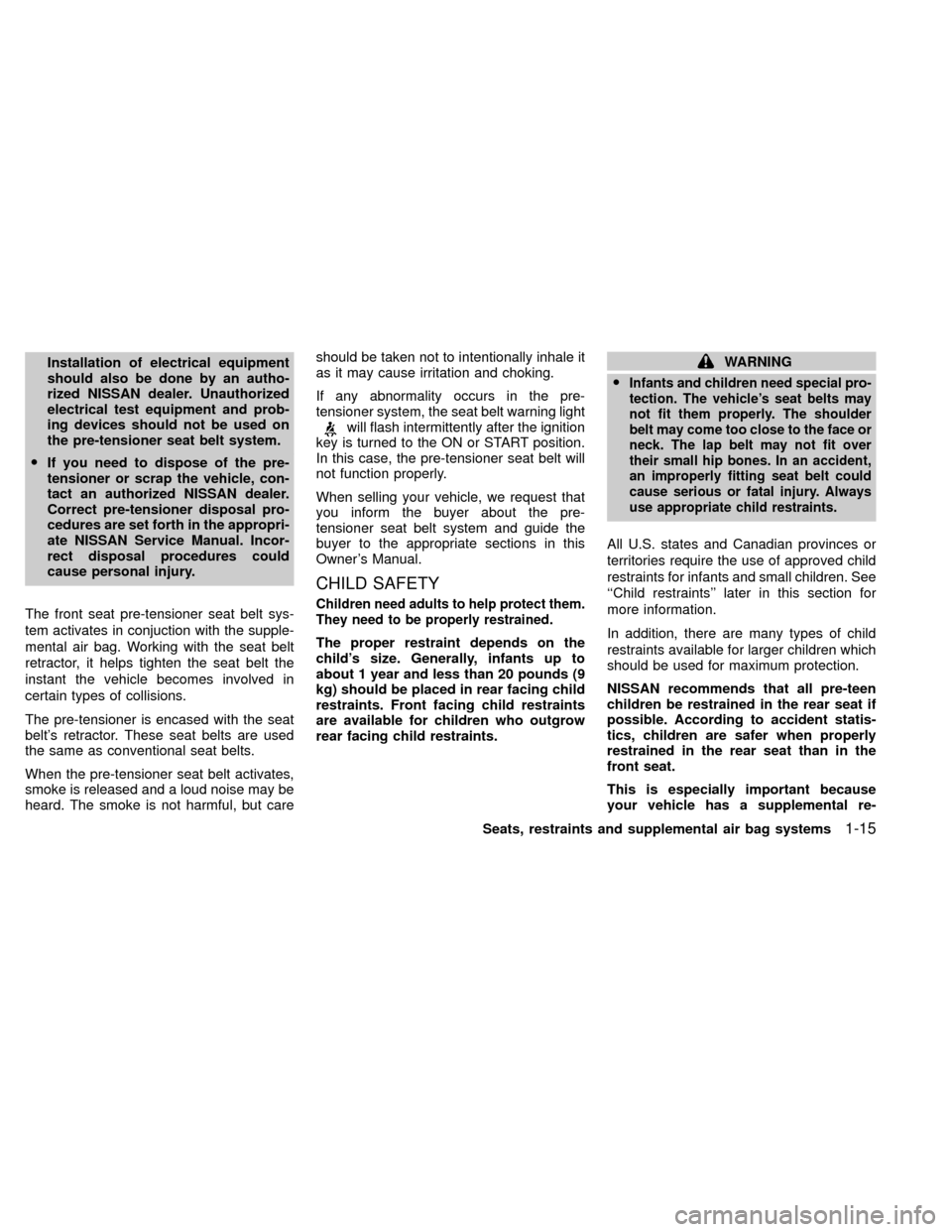
Installation of electrical equipment
should also be done by an autho-
rized NISSAN dealer. Unauthorized
electrical test equipment and prob-
ing devices should not be used on
the pre-tensioner seat belt system.
OIf you need to dispose of the pre-
tensioner or scrap the vehicle, con-
tact an authorized NISSAN dealer.
Correct pre-tensioner disposal pro-
cedures are set forth in the appropri-
ate NISSAN Service Manual. Incor-
rect disposal procedures could
cause personal injury.
The front seat pre-tensioner seat belt sys-
tem activates in conjuction with the supple-
mental air bag. Working with the seat belt
retractor, it helps tighten the seat belt the
instant the vehicle becomes involved in
certain types of collisions.
The pre-tensioner is encased with the seat
belt's retractor. These seat belts are used
the same as conventional seat belts.
When the pre-tensioner seat belt activates,
smoke is released and a loud noise may be
heard. The smoke is not harmful, but careshould be taken not to intentionally inhale it
as it may cause irritation and choking.
If any abnormality occurs in the pre-
tensioner system, the seat belt warning light
will flash intermittently after the ignition
key is turned to the ON or START position.
In this case, the pre-tensioner seat belt will
not function properly.
When selling your vehicle, we request that
you inform the buyer about the pre-
tensioner seat belt system and guide the
buyer to the appropriate sections in this
Owner's Manual.
CHILD SAFETY
Children need adults to help protect them.
They need to be properly restrained.
The proper restraint depends on the
child's size. Generally, infants up to
about 1 year and less than 20 pounds (9
kg) should be placed in rear facing child
restraints. Front facing child restraints
are available for children who outgrow
rear facing child restraints.
WARNING
O
Infants and children need special pro-
tection. The vehicle's seat belts may
not fit them properly. The shoulder
belt may come too close to the face or
neck. The lap belt may not fit over
their small hip bones. In an accident,
an improperly fitting seat belt could
cause serious or fatal injury. Always
use appropriate child restraints.
All U.S. states and Canadian provinces or
territories require the use of approved child
restraints for infants and small children. See
``Child restraints'' later in this section for
more information.
In addition, there are many types of child
restraints available for larger children which
should be used for maximum protection.
NISSAN recommends that all pre-teen
children be restrained in the rear seat if
possible. According to accident statis-
tics, children are safer when properly
restrained in the rear seat than in the
front seat.
This is especially important because
your vehicle has a supplemental re-
Seats, restraints and supplemental air bag systems
1-15
ZX
Page 49 of 263
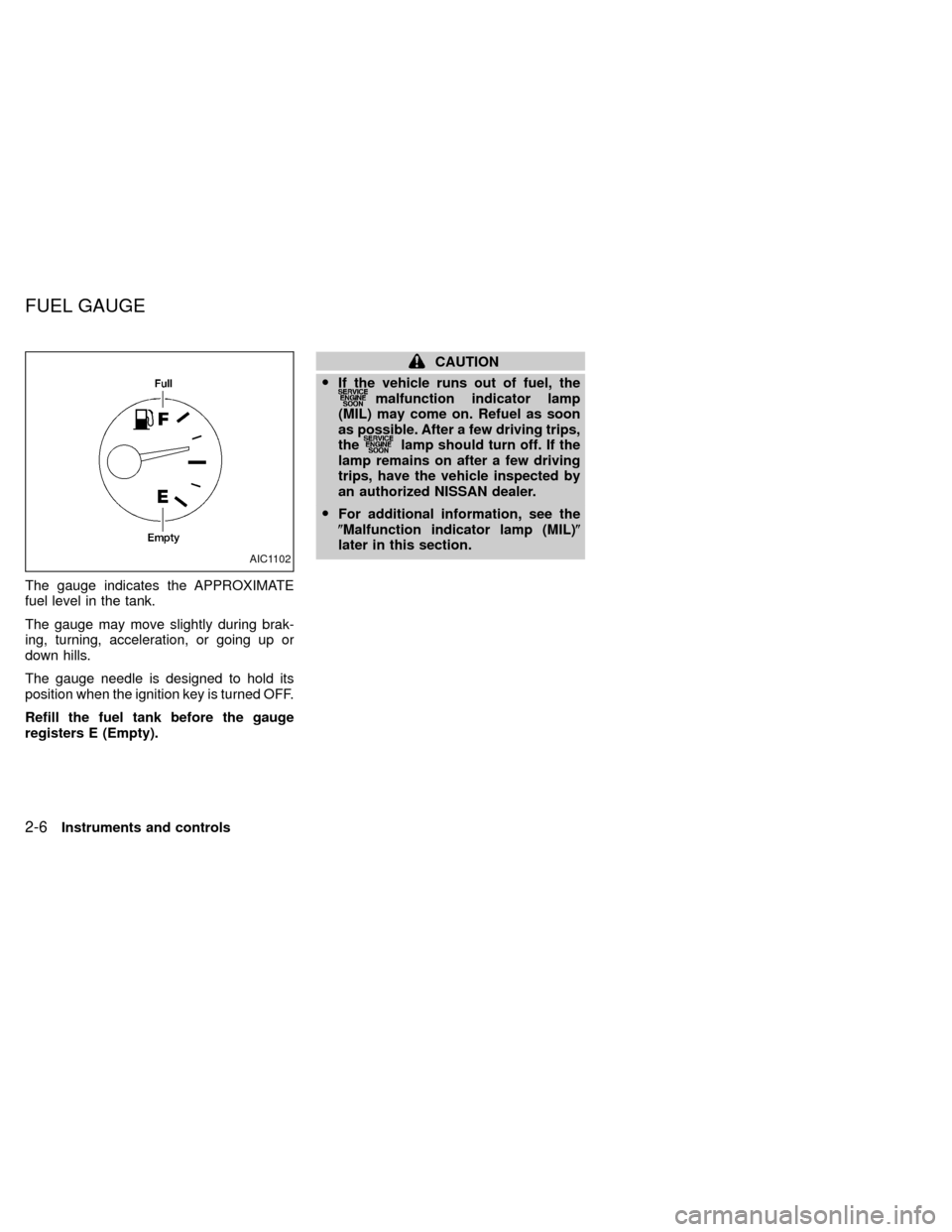
The gauge indicates the APPROXIMATE
fuel level in the tank.
The gauge may move slightly during brak-
ing, turning, acceleration, or going up or
down hills.
The gauge needle is designed to hold its
position when the ignition key is turned OFF.
Refill the fuel tank before the gauge
registers E (Empty).
CAUTION
OIf the vehicle runs out of fuel, the
malfunction indicator lamp
(MIL) may come on. Refuel as soon
as possible. After a few driving trips,
the
lamp should turn off. If the
lamp remains on after a few driving
trips, have the vehicle inspected by
an authorized NISSAN dealer.
OFor additional information, see the
(Malfunction indicator lamp (MIL)(
later in this section.
AIC1102
FUEL GAUGE
2-6Instruments and controls
ZX
Page 50 of 263
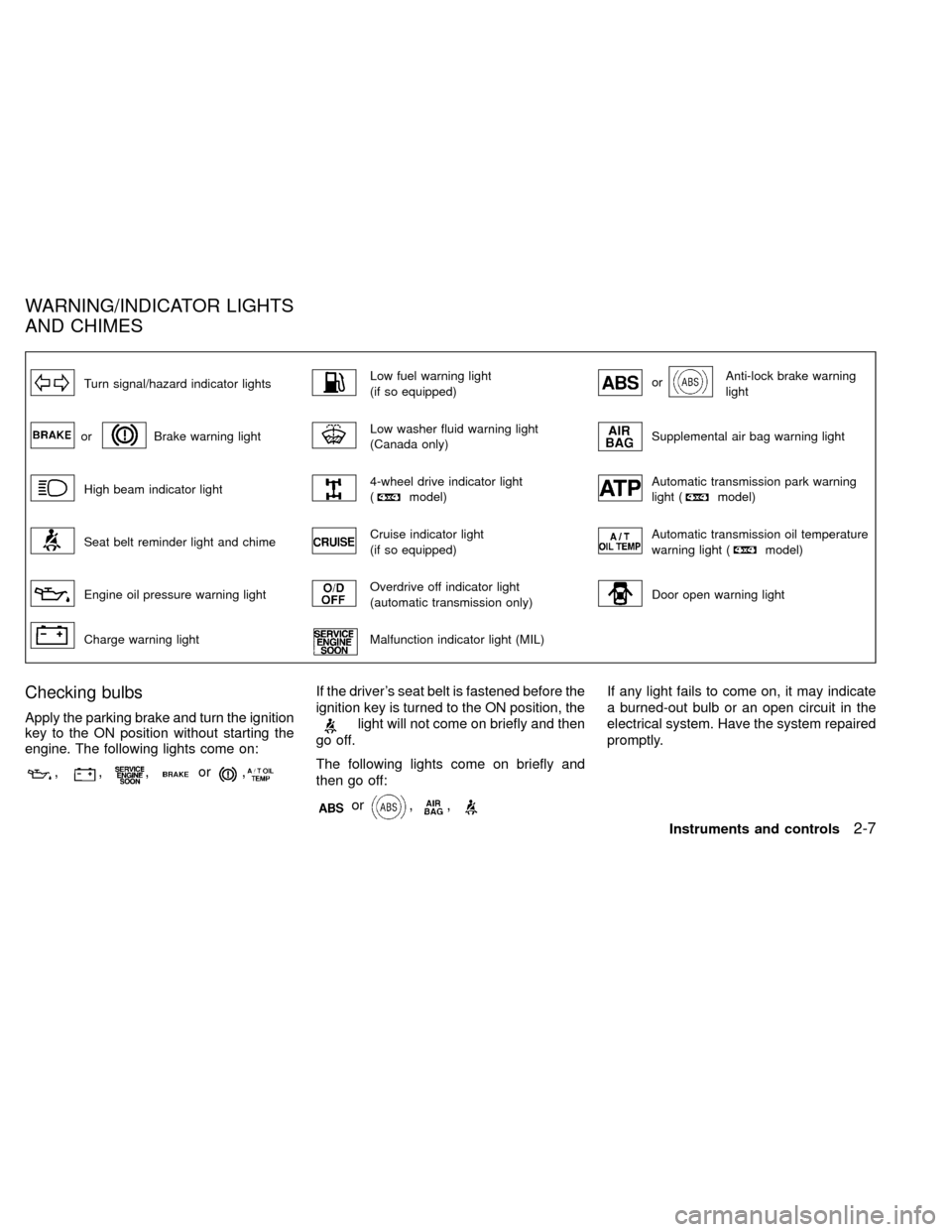
Turn signal/hazard indicator lightsLow fuel warning light
(if so equipped)orAnti-lock brake warning
light
orBrake warning lightLow washer fluid warning light
(Canada only)Supplemental air bag warning light
High beam indicator light4-wheel drive indicator light
(model)Automatic transmission park warning
light (model)
Seat belt reminder light and chimeCruise indicator light
(if so equipped)Automatic transmission oil temperature
warning light (model)
Engine oil pressure warning lightOverdrive off indicator light
(automatic transmission only)Door open warning light
Charge warning lightMalfunction indicator light (MIL)
Checking bulbs
Apply the parking brake and turn the ignition
key to the ON position without starting the
engine. The following lights come on:
,,,or,
If the driver's seat belt is fastened before the
ignition key is turned to the ON position, the
light will not come on briefly and then
go off.
The following lights come on briefly and
then go off:
or,,
If any light fails to come on, it may indicate
a burned-out bulb or an open circuit in the
electrical system. Have the system repaired
promptly.
WARNING/INDICATOR LIGHTS
AND CHIMES
Instruments and controls2-7
ZX